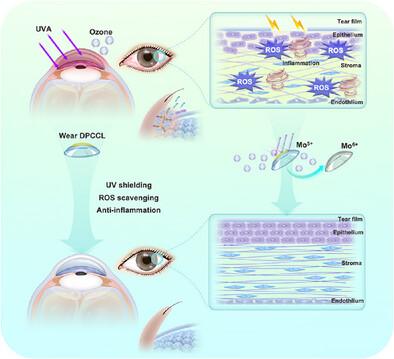静电工程多金属氧酸盐隐形眼镜集成屏蔽紫外线辐射和臭氧引起的眼压
IF 19
1区 材料科学
Q1 CHEMISTRY, MULTIDISCIPLINARY
引用次数: 0
摘要
眼睛极易受到空气污染和紫外线(UV)辐射等环境压力的影响,往往导致眼部疾病,但目前的保护策略仍然是零散和短暂的。本研究提出一种功能化纳米复合隐形眼镜,具有视觉清晰度、防紫外线、抗氧化活性和供氧功能。将阳离子[2-(甲基丙烯氧基)乙基]三甲基氯化铵(DMC)引入到传统凝胶状隐形眼镜中,将其从致密结构转变为多孔结构,从而引入共聚合策略。该方法通过静电相互作用显著提高了深蓝色钼基多金属氧酸盐(POM)活性氧(ROS)清除剂的负载能力。在光学区内,将Mo5+-POM选择性氧化为无色的Mo6+-POM,从而产生基于dmc -POM的化妆品隐形眼镜(DPCCL),该眼镜在保持商业级透明度的同时具有优异的紫外线屏蔽和活性氧清除能力。此外,在清除ROS的过程中,DPCCL产生氧气并发生颜色变化,从而延长了磨损时间,为监测ROS清除提供了视觉指标。体外和体内研究均证实,DPCCL可降低促炎细胞因子,保持角膜上皮的完整性,减轻臭氧引起的干眼症状。这些发现奠定了DPCCL作为一个持续和主动的眼部保护平台,为维持眼表健康对抗环境氧化应激提供了全面的解决方案。本文章由计算机程序翻译,如有差异,请以英文原文为准。

Electrostatically Engineered Polyoxometalate Contact Lenses for Integrated Shielding of UV Radiation and Ozone-Induced Ocular Stress
The eyes are highly vulnerable to environmental stressors like air pollution and ultraviolet (UV) radiation, often resulting in ocular diseases, yet current protective strategies remain fragmented and transient. This study presents a functionalized nanocomposite contact lens for ocular health improvement, featuring visual clarity, UV protection, antioxidant activity, and oxygen supply. A co-polymerization strategy is introduced by employing cationic [2-(methacryloyloxy)ethyl]trimethylammonium chloride (DMC) into traditional gel-like contact lenses, transforming them from a dense to a porous structure. This method significantly enhances the loading capacity of a reactive oxygen species (ROS) scavenger, dark blue molybdenum (Mo5+)-based polyoxometalate (POM), via electrostatic interactions. Selective oxidation of Mo5+-POM to colorless Mo6+-POM within the optical zone yields the DMC-POM-based cosmetic contact lens (DPCCL), which maintains commercial-grade clarity while exhibiting superior UV shielding and ROS scavenging capabilities. Furthermore, during ROS scavenging, DPCCL generates oxygen and undergoes color changes, enabling prolonged wear and providing a visual indicator for ROS elimination monitoring. Both in vitro and in vivo studies confirm that DPCCL reduces pro-inflammatory cytokines, preserves corneal epithelial integrity, and alleviates ozone-induced dry eye symptoms. These findings establish DPCCL as a continuous and proactive ocular protection platform, providing a comprehensive solution for maintaining ocular surface health against environmental oxidative stress.
求助全文
通过发布文献求助,成功后即可免费获取论文全文。
去求助
来源期刊

Advanced Functional Materials
工程技术-材料科学:综合
CiteScore
29.50
自引率
4.20%
发文量
2086
审稿时长
2.1 months
期刊介绍:
Firmly established as a top-tier materials science journal, Advanced Functional Materials reports breakthrough research in all aspects of materials science, including nanotechnology, chemistry, physics, and biology every week.
Advanced Functional Materials is known for its rapid and fair peer review, quality content, and high impact, making it the first choice of the international materials science community.
 求助内容:
求助内容: 应助结果提醒方式:
应助结果提醒方式:


